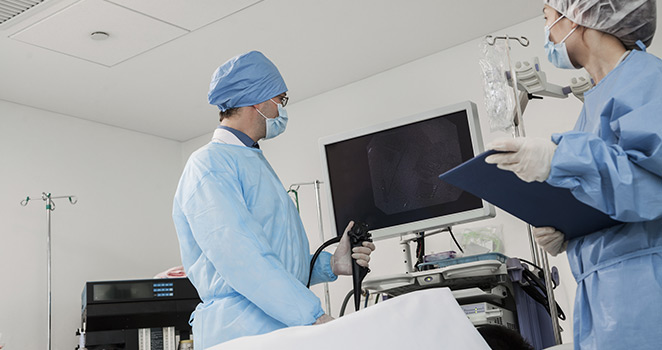Atrium Health Navicent Gastroenterology
Endoscopic Retrograde Cholangiopancreatography (ERCP)

Understanding ERCP
ERCP is Endoscopic retrograde cholangiopancreatography. ERCP is a procedure that is used to simultaneously diagnose and treat existing gastrointestinal issues relating to the bile ducts, the pancreatic duct and gallbladder. This procedure combines the use of an upper gastrointestinal (GI) endoscopy with x-rays to successfully examine and treat duct related upper GI issues. The esophagus, stomach and the upper components of the small intestine are included in the GI.
A non-invasive testing source is used in place of ERCP, such as the magnetic resonance cholangiopancreatography (MRCP), when only a diagnosis is needed. Doctors only utilize the ERCP when they are adequately confident that they can both diagnose and treat the issue during the procedure.
The ERCP is used to treat narrowed or blocked bile or pancreatic ducts. Blockages in the ducts may be caused by tumors, infections, or sclerosis, which is scarring. Pancreatitis may create inflammation. Gallstones that have been formed in the gallbladder may become lodged in the ducts. Sphincters are valves within the ducts. These valves can sometimes fail and may block a duct. Pseudo cysts may form from an accumulation of fluid or debris from tissue, and this can clog the ducts.
Preparation
Preparation instructions for ERCP are provided by the physician's office. Because the upper GI is going to be examined, it must be completely empty. Eating and drinking are commonly stopped eight hours before the procedure. Smoking, chewing gum and some medications will be restricted, until the procedure is completed. Medications that affect blood clotting or that may interact with sedatives are to be temporarily stopped. Restrictions will also include aspirin, ibuprofen (Advil) and Naproxen (Aleve), dietary supplements and antidepressants. Medications treating high blood pressure and diabetes must also be temporarily stopped. Patients must secure a ride home following the procedure. The sedatives used during the ERCP procedure must completely wear off before driving. Driving should be restricted for 12 to 24 hours.
ERCP Procedure
The ERCP will be conducted at a hospital or outpatient center. A local anesthetic is sprayed into the mouth and onto the back of the throat. This anesthetic is used to gently numb the throat. This also counteracts the natural gag reflex. Sedatives will be given via an intravenous needle in a vein in the arm. Medical staff will monitor the patient's vital signs while the procedure is completed.
The patient will rest on their back or side on an x-ray table, while they are sedated. There will be air blown into the esophagus. The air will allow the endoscope to move more freely. The doctor will insert the endoscope into the esophagus, and then extend it into the stomach and the duodenum.
The duodenum is the very first part of the small intestine. This portion of the small intestines plays a key role in digestion. A small camera is attached to the endoscope, and the images that are obtained are transmitted to the computer screen where the doctor views them. The duodenum papilla is a primary mechanism in the digestive system involved in the secretion of bile and other components that facilitate the digestion of food.
The doctor will guide a catheter tube through the endoscope and into the papillary opening. A colored dye would then be injected into the ducts using the catheter. This die will create a contrast that allows the ducts to be viewed on x-rays. X-rays will be completed. The doctor will closely view the images, as he looks for narrowed passages or blockages in the ducts.
Risks
ERCP risks include infection, pancreatitis, or hemorrhaging, allergic responses to sedatives, tissue damage, a puncture, or tear in the G.I. tract or duct and the possible loss of life. Experienced doctors performing the ERCP procedure share statistics that show six to ten percent of patients experience complications. Individuals experiencing complications often require hospitalization. Patients experiencing difficulty swallowing, increased pain in the throat, chest or stomach, vomiting, bloody, or dark stool or fever must contact the doctor immediately.
Treatment
Narrowed passages or blockages that are located in the ducts will be opened using special tools that are guided through the endoscope. The doctor will assess the issue and determine how to address the issue that is displayed in the x-rays. He will use the special tools on the endoscope to open any blockages, break or remove gallstones, and remove tumors. Stents are sometimes inserted. They are expandable plastic or metal tubes that will remain in the ducts to allow the flow of bile or pancreatic fluids. ERCP may be needed after a gallbladder surgery if a surgical bile leak occurs. The ERCP procedure will help the doctor to find the leak and insert a temporary stent.
Recovery
Following the ERCP procedure, patients are moved into a recovery room. They will rest for about an hour. Sedatives will take a while to wear off, and the patient will have a reduced memory of events before and after the procedure. The patient may feel bloated from the inserted air, and may experience gas. They may have a sore throat that lasts for a day or two. The ERCP results will be shared with the patient immediately following the procedure. The doctor will be available to answer any questions and concerns. Any biopsies that have been taken will be available in a few days. After the effects of the sedatives have diminished, the patient can be driven home. They should plan to rest quietly at home for the rest of the day.